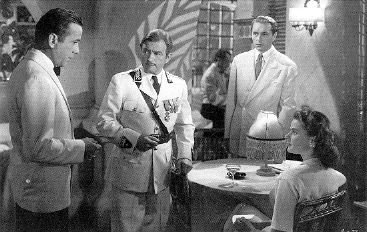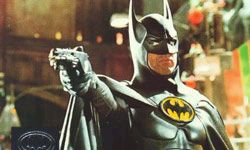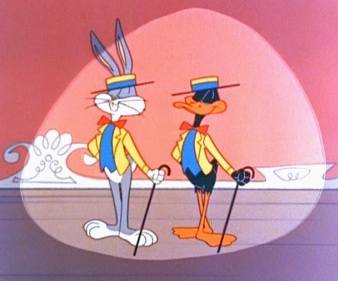|
WARNER BROS and TIME WARNER
|
||||||||||||||||||||||||||||
|
HOME | BIOLOGY | FILMS | GEOGRAPHY | HISTORY | INDEX | INVESTORS | MUSIC | NEWS | SOLAR BOATS | SPORT |
||||||||||||||||||||||||||||
|
Warner Bros. Entertainment is one of the world's largest producers of film and television entertainment. It is currently a subsidiary of the Time Warner conglomerate, with headquarters in Burbank, California, USA.
Warner Bros. includes several subsidiary companies, among them Warner Bros. Studios, Warner Bros. Pictures, WB Television, Warner Home Video, Castle Rock Entertainment, Turner Entertainment, Dark Castle Entertainment, DC Comics, and the remnants of Hanna-Barbera Cartoons, Inc., although the former Hanna-Barbera studio is now known as Cartoon Network Studios and is under Turner Broadcasting.
The company prefers that its name be spelled "Warner Bros.", not "Warner Brothers".
History
The corporate name honors the four founding Warner brothers, Harry Warner (18811958), Albert Warner (18831967), Sam Warner (18871927) and Jack L. Warner (18921978). The three elder brothers began in the exhibition business in 1903, having acquired a projector with which they showed films in the mining towns of Pennsylvania and Ohio. They opened their first theatre, the Cascade, in New Castle, Pennsylvania in 1903, and then in 1904 founded the Pittsburgh-based Duquesne Amusement & Supply Company (the precursor to Warner Bros. Pictures) to distribute films. Within a few years this led to the distribution of pictures across a four-state area. By the time of World War I they had begun producing films, and in 1918 the brothers opened the Warner Bros. studio on Sunset Boulevard in Hollywood. Sam and Jack Warner produced the pictures, while Harry and Albert handled finance and distribution in New York. In 1923, they formally incorporated as Warner Bros. Pictures, Inc.
The first important deal for the company was the acquisition of the rights to Avery Hopwood's 1919 Broadway play The Gold Diggers from theatrical impresario David Belasco. However, what really put Warner Bros. on the Hollywood map was a dog, Rin Tin Tin, brought from France after Wrld War I by an American soldier. Rinty was so popular that he starred in 26 films, beginning with The Man from Hell's River in 1924, and is credited with making the fledgling studio a success.
As the studio prospered, it gained backing from Wall Street, and in 1924 Goldman Sachs arranged a major loan. With this new money Warners bought the pioneer Vitagraph Company which had a nation-wide distribution system, and as a bonus got an experimental synchronized-sound process called 'Vitaphone'. They also plunged into radio, establishing radio stations in several major cities, among them KFWB in Los Angeles. Warners also joined the mad race to buy and build theaters.
At the urging of Sam Warner, the company committed to develop Vitaphone, and in 1926 began making films with music and effects tracks. When this proved popular, they took the next step and offered, in October 1927 a picture with dialogue, one that would revolutionize the business, The Jazz Singer, starring Al Jolson. The movie was a sensation, launching the era of "talking pictures" and banishing silent movies. But unfortunatly, the brothers missed the premiere of The Jazz Singer due to Sam's funeral.
Flush with cash thanks to the success of The Jazz Singer, in 1928 Warner bought the Stanley Company, a major theater chain. This gave them a share in rival First National Pictures, of which Stanley owned one-third. In a bidding war with William Fox, Warner bought more First National shares, and gained control in 1929. The Justice Department agreed to allow the purchase if First National was maintained as a separate company. But when the depression hit, Warner asked for and got permission to merge the two studios; soon afterward Warner Bros. moved to the First National lot in Burbank. Though the companies merged, Justice required Warner to produce and release a few films each year under the First National name until 1938. For thirty years, certain Warner productions would be identified (mainly for tax purposes) as 'A Warner Bros. - First National Picture.'
A scene from WB's 1942 film Casablanca - starring Humphrey Bogart and Ingrid Bergman
Under production head Darryl F. Zanuck, Warners in the 1930s became known for gritty, 'torn from the headlines' pictures that some said glorified gangsters. Warner stars tended to be tough-talking, working-class types, among them James Cagney, Joan Blondell, Edward G. Robinson and Barbara Stanwyck. After Zanuck was succeeded by Hal B. Wallis in 1933, the studio tried for a more sophisticated style, offering melodramas (or 'women's pictures'), swashbucklers, and expensive adaptations of best-sellers, with stars like Bette Davis, Olivia de Havilland, Paul Muni and Errol Flynn.
Warner's cartoon unit began modestly in 1930 as a free-standing company owned by Leon Schlesinger. Several former Disney animators, including Hugh Harman, Rudolf Ising, Jack King, and Friz Freleng offered tame cartoons starring Bosko the Talk-Ink Kid and Buddy. However, with the arrival of Tex Avery and the creation of Termite Terrace, the unit developed a fast-paced, irreverently insane style that made them immensely popular world-wide. Warner bought Schlesinger's cartoon unit in 1944, and in subsequent decades characters such as Bugs Bunny and Daffy Duck became central to the company's image.
The record attendance figures of the World War II years made the Warner brothers rich. The gritty Warner image of the 1930s gave way to a glossier look, especially in women's pictures starring Davis, de Havilland and Joan Crawford. The 1940s also saw the rise of Humphrey Bogart from supporting player to major star. And in the post-war years Warners continued to create new stars, like Lauren Bacall and Doris Day.
On January 5, 1948, Warner offered the first color newsreel, covering the Tournament of Roses Parade and the Rose Bowl.
Warner was a party to the U.S. vs Paramount Pictures, et al. anti-trust case of the 1940s. This action, brought by the Justice Department and the Federal Trade Commission, claimed that the five integrated studio-theater chain combinations restrained competition. The Supreme Court heard the case in 1948, and ruled for the government. As a result Warner and four other major studios were forced to separate production from exhibition. Early in 1953, the Warner theater holdings were spun off as Stanley Warner Theaters. With no more theaters to fill there was no need to produce thirty pictures a year, and no need for expensive contract-actors or for costly staff. After fifty years in the business the Warners saw the system winding down, and agreed to sell the studio to a bank-led syndicate. Only after the deal was completed in 1956 did elder brothers Harry and Albert Warner learn that the leading investor in the bank's syndicate was youngest brother Jack, who now had control of what had been a family business. Even in an argument-prone family like the Warners, this was too much, and led to a rupture in family relations. For the rest of their lives the brothers did not speak to one another. But Jack was solely in charge at Warner Bros. Pictures.
For a time Warner Bros. rebounded, specializing in adaptations of popular plays like The Bad Seed, No Time for Sergeants and Gypsy: A Musical Fable. There was also a successful television unit, offering popular series like 77 Sunset Strip and Maverick. Already the owner of extensive music-publishing holdings, in 1958 the studio launched Warner Brothers Records. But by the 1960s, the company was winding down. There were few studio-produced films and many more co-productions (for which Warner provided facilities, money, and distribution), and pickups of independently made pictures. In 1967, Jack gave in to advancing age and the changing times, selling control of the studio and its music business for $78 million to Seven Arts Productions, run by the Canadian investors Elliot and Kenneth Hyman, whose Associated Artists Productions had once owned the pre-1948 Warner film library. The company, including the studio, was renamed Warner Bros.-Seven Arts.
Michael Keaton as Batman in 1992's Batman Returns
Two years later the Hymans accepted a cash-and-stock offer from an odd conglomerate called Kinney National Company. Originating as a chain of funeral parlors, Kinney had grown by buying service businesses like parking lots, office cleaners, and a Hollywood talent agency, Ashley-Famous. It was Ted Ashley who led Kinney-head Steve Ross to the purchase of Warners, and Ashley became the new head of the studio, again called Warner Bros. Pictures. Although the movie-going audience had shrunk, Warner's new management believed in the drawing-power of stars, signing co-production deals with the big names of the day, among them Paul Newman, Robert Redford, Barbra Streisand, John Wayne, and Clint Eastwood. This star-driven policy carried the studio successfully through the 1970s and 1980s. Abandoning the mundane parking lots and funeral homes, the re-focused Kinney renamed itself in honor of its best-known holding, Warner Communications. In the 80's Warner Communications branched out into other business, such as Atari video games, and the Six Flags theme parks.
To the surprise of many, flashy, star-driven Warner Communications merged in 1989 with the white-shoe publishing company Time, Inc. Though Time and its magazines claimed a higher tone, it was the Warner Bros. film and music units which provided the profits. In 1997 Time Warner sold the Six Flags unit. The takeover of Time-Warner in 2000 by then-high-flying AOL did not prove a good match, and following the collapse in "dot-com" stocks, the AOL name was banished from the corporate nameplate.
In 1995, Warner and station-owner Tribune Company of Chicago launched The WB Network, finding a niche market in teen-agers. The WB's early programming included an abundance of angsty teenage fare like Buffy the Vampire Slayer, 7th Heaven and Dawson's Creek. In 2006 Warner and CBS Corporation decided to close the The WB and CBS's UPN and jointly launch The CW Television Network.
In the late 1990s, Warners obtained rights to the Harry Potter novels, and released feature film adaptions of the first in 2001, the second in 2002, the third in 2004, and the fourth in November 2005. The fifth is slated for June 2007.
Film library
Over the years, a series of mergers and acquisitions have helped Warners (the present-day Time-Warner subsidiary) to accumulate a diverse collection of movies, cartoons, and television programs.
In the aftermath of the 1948 anti-trust suit, uncertain times led Warners in 1956 to sell its 650 of its pre-1948 films and cartoons to a holding company which became Associated Artists Productions (AAP). Two years later AAP sold its holdings to United Artists (UA), which held them until 1981, when MGM bought UA. Three years later Turner Broadcasting System, having failed to buy MGM, settled for ownership of the MGM/UA library. This included all pre-1986 MGM features as well as the pre-1948 Warner material. Ownership of the classic Warner films came full-circle when Time Warner bought Turner, although technically they are held by Turner Entertainment while Warner is responsible for sales and distribution.
These acquisitions, among others, mean that Warner owns almost every film they've made since inception (excepting certain films Warner merely distributed, such as the United States Pictures catalog, except for Battle of the Bulge, which WB still owns). Certain of John Wayne's Warner films are owned by Batjac, Wayne's company. Seven years after its 1964 release, rights to My Fair Lady reverted to CBS, which had backed the theatrical production. (Interestingly, 35 years after that, CBS and Warner Bros. will form The CW Television Network, as mentioned above.)
As noted, Warner owns all pre-1985 MGM titles; a majority of the RKO Radio Pictures library; and a portion of United Artists material (most of this under its Turner subsidiary). In addition Warner has acquired the Hanna-Barbera Productions television cartoons; most of Lorimar's television and film holdings (including the Allied Artists / Monogram library; most ancillary rights to Castle Hill Productions library (which includes early UA material); and a few films released by others, such as the 1956 version of Around the World in Eighty Days; most of the Saul Zaentz film library; the post-1974 Rankin-Bass library; and Castle Rock Entertainment films made after Turner acquired Castle Rock (except The Story of Us).
UA donated pre-1949 Warner Bros. nitrates to the Library of Congress and post-1951 negatives to UCLA's film library. Most of the company's legal files, scripts and production materials were donated to the University of Wisconsin-Madison.
Bugs Bunny and Daffy Duck
Notable Warner Brothers movies
The following is a partial list of films that Warner Bros. has produced, co-produced, and/or distributed:
1940s
1950s
1960s
1970s
1980s
1990s
2000s
Online Exclusives
References
Time Warner Inc. or TimeWarner (NYSE: TWX) (AOL Time Warner Inc. between 2001 and 2003) is the world's largest media company with major Internet, publishing, film, telecommunications and television divisions. The company is headquartered in New York City.
History
Time Warner was created in 1990 by the merger of Time Inc. and Warner Communications. This company subsequently acquired Ted Turner's Turner Broadcasting System on October 1996.
AOL merger
In 2001, a new company called AOL Time Warner was created when AOL purchased Time Warner. The deal, announced in 2000, employed an unusual merger structure in which each original company merged into a newly created entity. The Federal Trade Commission approved the deal on December 14, 2000. It was then subject to a public comment period of 30 days, until January 16, 2001.
There has been some speculation about the motivations of each party. Some observers believed that Time Warner was struggling to integrate "new media" into its business. A merger with AOL provided a huge subscriber base of Internet users, along with online marketing know-how. Many business journalists have reported that AOL executives felt that AOL stock was severely overvalued and that a big merger was the only way to prevent a collapse in valuation.
The merger faced immediate opposition by consumer groups and other media companies on antitrust grounds.
Media companies felt that the vertically integrated AOL Time Warner would unfairly promote its own content within its outlets. This fear existed before the merger, but Time Warner was thought to be a conglomeration of very independent divisions. It was feared that this would change with the influence of AOL executives.
Consumer advocates were concerned with the threat of product tying between Time Warner's cable TV systems and AOL's Internet service. Some consumer groups saw a possible attempt to corner the Internet-over-TV market, whereby AOL could force all of the Time Warner cable subscribers to use AOL branded Internet-TV. Smaller internet service providers feared that AOL would tie its Internet service to Time Warner's cable modem service. Some ISPs wanted the opportunity to use Time Warner's cable network as a common carrier for their services, which competed with AOL. AOL and Time Warner pledged not to violate any antitrust regulations.
Many observers were shocked that a large, diversified media conglomerate was being acquired by a much smaller company. Market conditions at the time of the merger placed a greater premium on Internet-related stocks than on traditional media stocks. AOL's high market capitalization relative to that of Time Warner made the acquisition possible. The deal has since become a symbol of the Internet Bubble and is widely regarded as a disaster, with a $2.4 billion shareholder settlement, a further $600 million set aside and a $5 billion price boosting share buyback program announced on August 3, 2005.
AOL CEO Steve Case became executive chairman of the new company, while Time Warner CEO Gerald Levin retained the CEO title.
Post-merger
After the merger, the profitabilty of the ISP division (America Online) decreased. Meanwhile, the market valuation of similar independent internet companies fell dramatically. As a result, the value of the America Online division dropped significantly. This forced a goodwill write down, causing AOL Time Warner to report a loss of 99 billion dollars in 2002--at the time, the largest loss ever reported by a company.
In response to the huge loss in 2002, the company dropped the "AOL" from its name, and removed Steve Case as executive chairman. Richard Parsons became the new CEO. Case resigned from the Time Warner board on October 31, 2005.[2]
Since the merger, a number of transactions have taken place:
CW Network
Starting in September 2006, Time Warner, the Tribune Company (Which owns The WB Television Network), and CBS Corporation (Which owns UPN) will partner with The CW Television Network, although CBS and Time Warner will each own 50% of the network, and Tribune and CBS will have its stations become the network's affliates.
Services
Time Warner Cable has since expanded and offers the following services:
Financials
In 2004, Time Warner's market capitalization was US$84 billion (2004). When the AOL-Time Warner merger was announced in January 2000, the combined market capitalization was $280 billion.
For fiscal year 2002 the company reported a $99 billion loss on its income statement ([4]) because of $100 billion in non-recurring charges, almost all from a writedown of the goodwill (intangible asset) from the merger in 2000. (The value of the AOL portion of the company had dropped sharply with the collapse of the Internet boom, in the early 2000s.)
Commercial propertiesTime Warner Inc. owns several large properties in New York City; certain buildings in the Rockefeller Center complex and adjacent office towers house its main offices; one of which houses a CNN news studio. In late 2003, Time Warner finished construction of a new twin-tower complex, designed to serve as additional office space, facing Columbus Circle on the southwestern edge of Central Park. Originally called the AOL Time Warner Center, the 755-foot, 55-floor mixed-use property was renamed Time Warner Center when the company itself was
Board of directors
As of November 2005.
LINKS:
A - Z FILMS INDEX
A - Z ACTORS INDEX
A taste for adventure capitalists
Solar Cola - a healthier alternative
|
||||||||||||||||||||||||||||
|
This
website
is Copyright © 1999 & 2012 NJK. The bird |
||||||||||||||||||||||||||||
|
AUTOMOTIVE | BLUEPLANET | ELECTRIC CARS | ELECTRIC CYCLES | SOLAR CARS |
||||||||||||||||||||||||||||




